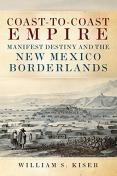BKMT READING GUIDES
Coast-to-Coast Empire: Manifest Destiny and the New Mexico Borderlands
by William S. Kiser
Published: 2018-08-09
Hardcover : 288 pages
Hardcover : 288 pages
1 member reading this now
0 club reading this now
0 members have read this book
0 club reading this now
0 members have read this book
Following Zebulon Pike’s expeditions in the early nineteenth century, U.S. expansionists focused their gaze on the Southwest. Explorers, traders, settlers, boundary adjudicators, railway surveyors, and the U.S. Army crossed into and through New Mexico, transforming it into a ...
No other editions available.
Jump to
Introduction
Following Zebulon Pike’s expeditions in the early nineteenth century, U.S. expansionists focused their gaze on the Southwest. Explorers, traders, settlers, boundary adjudicators, railway surveyors, and the U.S. Army crossed into and through New Mexico, transforming it into a battleground for competing influences determined to control the region.
Previous histories have treated the Santa Fe trade, the American occupation under Colonel Stephen W. Kearny, the antebellum Indian Wars, debates over slavery, the Pacific Railway, and the Confederate invasion during the Civil War as separate events in New Mexico. In Coast-to-Coast Empire, William S. Kiser demonstrates instead that these developments were interconnected parts of a process by which the United States effected the political, economic, and ideological transformation of the region.
New Mexico was an early proving ground for Manifest Destiny, the belief that U.S. possession of the entire North American continent was inevitable. Kiser shows that the federal government’s military commitment to the territory stemmed from its importance to U.S. expansion. Americans wanted California, but in order to retain possession of it and realize its full economic and geopolitical potential, they needed New Mexico as a connecting thoroughfare in their nation-building project. The use of armed force to realize this claim fundamentally altered New Mexico and the Southwest. Soldiers marched into the territory at the onset of the Mexican-American War and occupied it continuously through the 1890s, leaving an indelible imprint on the region’s social, cultural, political, judicial, and economic systems.
By focusing on the activities of a standing army in a civilian setting, Kiser reshapes the history of the Southwest, underlining the role of the military not just in obtaining territory but in retaining it.
Discussion Questions
No discussion questions at this time.Book Club Recommendations
Recommended to book clubs by 0 of 0 members.
MEMBER LOGIN
BECOME A MEMBER it's free
Book Club HQ to over 90,000+ book clubs and ready to welcome yours.
SEARCH OUR READING GUIDES
Search
FEATURED EVENTS
PAST AUTHOR CHATS
JOIN OUR MAILING LIST
Get free weekly updates on top club picks, book giveaways, author events and more
Get free weekly updates on top club picks, book giveaways, author events and more
Please wait...








